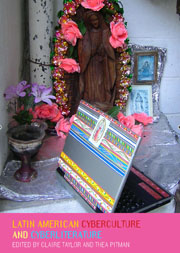Book contents
- Frontmatter
- Contents
- List of Illustrations
- Acknowledgements
- Foreword: Latin American Cyberliterature: From the Lettered City to the Creativity of its Citizens
- Notes on Contributors
- Introduction
- I Cyberculture and Cybercommunities
- II Cyberliterature: Avatars and Aficionados
- 9 Posthumanism in the Work of Jorge Luis Borges
- 10 Julio Cortázar's Rayuela and the Challenges of Cyberliterature
- 11 Contemporary Brazilian Fiction: Between Screens and Printed Pages
- 12 Creative Processes in Hypermedia Literature: Single Purpose, Multiple Authors
- 13 Hypertext in Context: Space and Time in the Hypertext and Hypermedia Fictions of Blas Valdez and Doménico Chiappe
- 14 Virtual Bodies in Cyberspace: Guzik Glantz's Weblog
- A Cyberliterary Afterword: Of Blogs and Other Matters
- Conclusion: Latin American Identity and Cyberspace
- Suggested Further Reading
- Index
14 - Virtual Bodies in Cyberspace: Guzik Glantz's Weblog
from II - Cyberliterature: Avatars and Aficionados
- Frontmatter
- Contents
- List of Illustrations
- Acknowledgements
- Foreword: Latin American Cyberliterature: From the Lettered City to the Creativity of its Citizens
- Notes on Contributors
- Introduction
- I Cyberculture and Cybercommunities
- II Cyberliterature: Avatars and Aficionados
- 9 Posthumanism in the Work of Jorge Luis Borges
- 10 Julio Cortázar's Rayuela and the Challenges of Cyberliterature
- 11 Contemporary Brazilian Fiction: Between Screens and Printed Pages
- 12 Creative Processes in Hypermedia Literature: Single Purpose, Multiple Authors
- 13 Hypertext in Context: Space and Time in the Hypertext and Hypermedia Fictions of Blas Valdez and Doménico Chiappe
- 14 Virtual Bodies in Cyberspace: Guzik Glantz's Weblog
- A Cyberliterary Afterword: Of Blogs and Other Matters
- Conclusion: Latin American Identity and Cyberspace
- Suggested Further Reading
- Index
Summary
Within the rapid growth of the use of the Internet as a form of expression in Latin America, the weblog, more commonly known by its shorthand ‘blog’, has taken a particularly strong hold in several Latin American countries. Worldwide, the number of weblogs was estimated at over 100 million in 2005 (Duncan 2005) although given the explosion of the weblog format, this number will no doubt already be out of date. The site bitacoras.com, a portal for blogs in Spanish, currently links to 148,566 Hispanic blogs (accessed 2 March 2006), with some 598 blogs in Mexico City alone. Other, smaller sites list blogs on a country-by-country basis, with the Mexican site, Blogsméxico, currently listing some 4599 at the present date of writing.
Reasons for the popularity of the blog format are many, some of which have been enumerated by Heriberto Yépez in his ‘Literatura weblog’. As Yépez notes, the popularity of this form of expression is partly due to the ease of opening and publishing a weblog, but also, crucially, is due to the ability to evade some of the problems associated with print publishing: ‘The weblog can serve as a refuge and as a stimulus for amateur or emerging authors whose probability of publishing (and, therefore, of the production of certain texts due to their length, ideology, themes or language) would be non-existent or smaller in print publishing and institutional spaces’ (Yépez 2003).
- Type
- Chapter
- Information
- Latin American Cyberculture and Cyberliterature , pp. 244 - 256Publisher: Liverpool University PressPrint publication year: 2007



